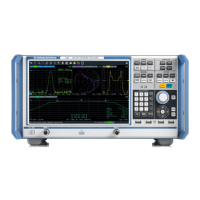Concepts and Features
R&S
®
ZNB/ZNBT
112User Manual 1173.9163.02 ─ 53
dinates in the normalized impedance plane and in the reflection coefficient plane are
related as follows (see also: definition of matched-circuit (converted) impedances):
Z / Z
0
= (1 + Γ) / (1 – Γ)
From this equation, it is easy to relate the real and imaginary components of the com-
plex resistance to the real and imaginary parts of Γ:
,
)Im()Re(1
)Im()Re(1
)/Re(
2
2
22
0
ZZR
2
2
0
)Im()Re(1
)Im(2
)/Im(
ZZX
According to the two equations above, the graphical representation in a Smith chart
has the following properties:
●
Real reflection coefficients are mapped to real impedances (resistances).
●
The center of the Γ plane (Γ = 0) is mapped to the reference impedance Z
0
,
whereas the circle with |Γ| = 1 is mapped to the imaginary axis of the Z plane.
●
The circles for the points of equal resistance are centered on the real axis and
intersect at Z = infinity. The arcs for the points of equal reactance also belong to
circles intersecting at Z = infinity (open circuit point (1, 0)), centered on a straight
vertical line.
Examples for special points in the Smith chart:
●
The magnitude of the reflection coefficient of an open circuit (Z = infinity, I = 0) is
one, its phase is zero.
●
The magnitude of the reflection coefficient of a short circuit (Z = 0, U = 0) is one, its
phase is –180 deg.
Inv Smith
For "Inv Smith" formatted traces, the response values are interpreted as complex
reflection coefficients S
ii
and represented in terms of their corresponding complex
admittance Y(S
ii
) = G(S
ii
) + j B(S
ii
).
Screen Elements

